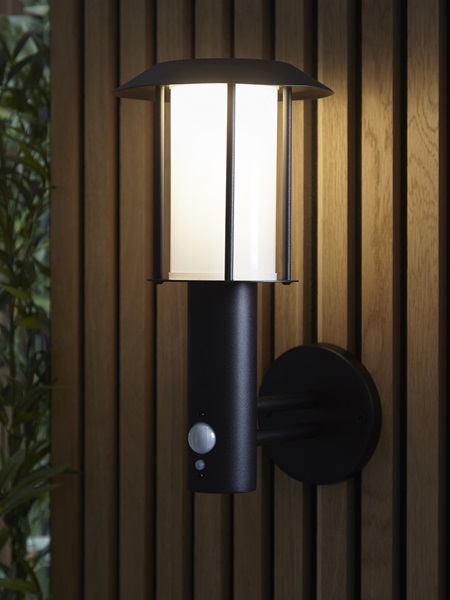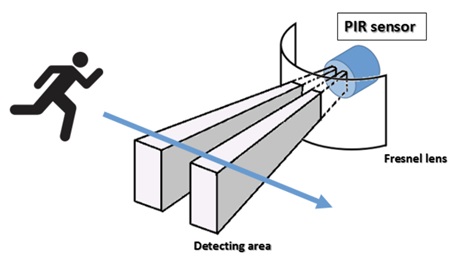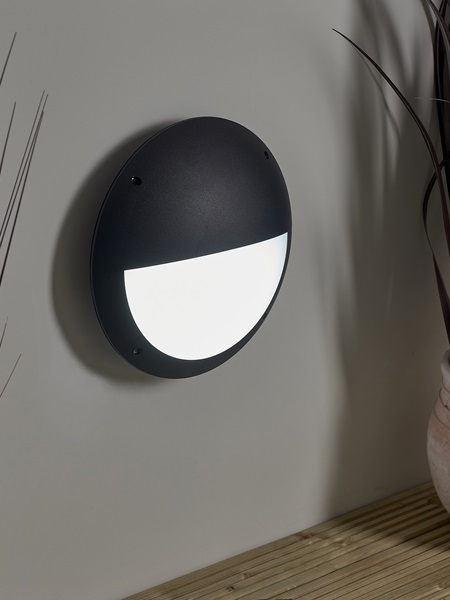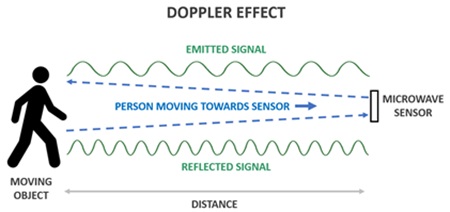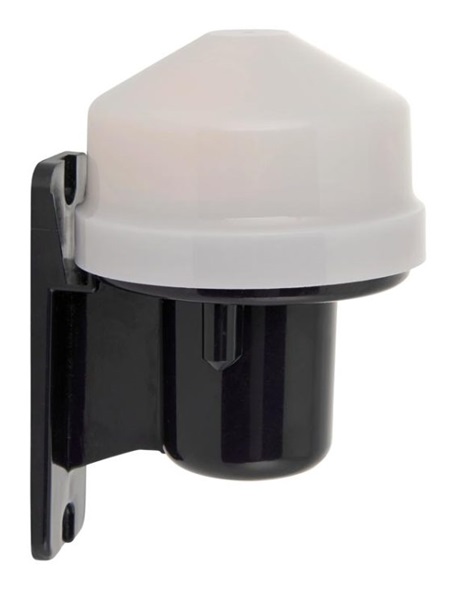Author: Mark Tregunna
This guide has been written so you can make an informed and confident decision when choosing the best motion sensor light for your needs. Backed by over 50 years of trusted service from Universal Lighting and more than 30 years of personal lighting expertise, I will take you through your options, together with the advantages and disadvantages of each, so you can find the right solution for your outdoor security lighting needs.
If you’re thinking about upgrading your outdoor lighting, motion sensor lights are a smart and practical choice. They can help protect your home, light up walkways and entrances, and cut down on wasted energy. But once you start looking into it, you’ll notice two main types: PIR motion sensor lights and microwave sensor lights.
What are motion sensor lights?
Motion sensor lights are designed to turn on automatically when they detect movement nearby. They’re often used in driveways, gardens, porches, and side entrances where you want light only when it’s needed.
There are a few types of sensors commonly used in outdoor lighting:
- PIR (passive infrared) sensors
- Microwave sensors
- Photocell sensors (also known as dusk to dawn)
What is a PIR motion sensor light?
PIR stands for passive infrared. These sensors detect heat from people, animals or vehicles moving across their detection zone. So rather than sensing motion directly, they pick up changes in infrared radiation.
Inside a PIR sensor are two small sensors that constantly measure infrared levels. When something warm moves across the sensor’s view, it causes an imbalance between the two readings. That’s what triggers the light.
What’s good about PIR sensor lights?
- They’re passive, which means they don’t emit any signals
- They’re usually affordable and widely available
- Many models offer adjustable settings for time and sensitivity
- Some include a manual override so you can keep the light on permanently if needed
Where they can fall short?
- They don’t always detect movement directly toward the sensor
- PIR sensors can be less reliable in very hot weather
- They may be triggered by pets or blowing branches
- If someone stands still within the detection zone, the light may turn off
PIR motion sensor lights are a great choice for most outdoor areas like porches, pathways, and garden sheds.
What is a microwave motion sensor light?
Microwave sensors work differently. They emit low power microwave signals that bounce off nearby objects and return to the sensor. If something moves and changes the time it takes for the signal to return, the light is triggered.
Because microwave sensors can detect through some materials (like plastic or glass), they’re more sensitive and cover a wider area. But they can’t detect through metal.
The sensor is very small and can usually be housed within the light fixture so as not to alter the overall look of the light fitting. They operate very efficiently through the shades and do not require any holes to be cut into the body, so the IP rating is not affected.
Why choose microwave sensor lights?
- They offer a wider detection range, ideal for large spaces
- They perform well in hot or cold weather
- They detect small or subtle movements, even through thin materials
- They tend to have fewer false alarms from animals or leaves
What to keep in mind
- Their sensitivity means they can trigger from movement in nearby rooms or roads
- They can be set off by heavy rain or strong winds
- They cost more than PIR models
- They won’t detect motion behind metal
Microwave sensor lights are a solid choice for larger areas like long driveways or outdoor workspaces.
PIR vs microwave: which is better?
Here’s a quick comparison to help you decide:
| Feature | PIR Sensor Lights | Microwave Sensor Lights |
|---|---|---|
| Detection method | Body heat (infrared) | Microwave signal reflection |
| Sensitivity | Moderate | High |
| Can detect through walls | No | Yes (except metal) |
| Prone to false alarms | Higher in heat or wind | Lower, but still possible |
| Best suited for | Entrances, porches, walkways | Large gardens, driveways, garages |
| Price | More affordable | Higher cost |
Both types are effective. PIR sensor lights are ideal for everyday use around the home, while microwave sensor lights are better suited to a wider area of detection.
What about photocell (dusk to dawn sensor) lights?
Photocells detect ambient light instead of motion. They switch your outdoor lights on at dusk and off at dawn, automatically. They’re low maintenance and great for homes where you want lighting to come on every evening without needing to touch a switch.
There are also standalone photocells available with a countdown timer included. For example, if you set the timer to 4 hours, once it gets dark, your lights will illuminate, but only for 4 hours, then switch off.
Most PIR and microwave sensor lights come with a built-in photocell so they only activate after dark. It’s a useful feature that helps save energy and avoids unnecessary switching.
Should you choose a built-in or remote sensor?
Some motion sensor lights have the sensor built into the fitting, while others use a remote sensor installed separately.
Built-in sensors are easy to install and are usually the choice for residential lighting.
Remote sensors offer more flexibility. You can place the sensor where you need it most and control more than one light from one unit. Many also come with additional settings like adjustable sensitivity and activation time.
Manual override: what is it and when to use it?
Many outdoor lights come with a manual override feature. This allows you to switch the light on permanently, bypassing the sensor. It’s handy when you’re spending time outdoors in the evening and don’t want the light to keep switching off.
In most cases, you can activate override mode by flicking the switch off and on twice quickly. To return to normal operation, turn it off for about 10 seconds and switch it back on again.
Shop Lights With Manual Override
What else should you consider?
Before choosing a motion sensor light, think about:
- The power source – mains, solar, or battery
- How bright the light is and the beam angle
- The detection range and sensitivity (some models offer multiple settings)
- In addition, it is important to choose one suitable for outdoor use that is protected from adverse weather conditions, e.g., weatherproofing and UV resistant if possible. (check the IP rating)
If you’re going for a wired unit, you might need help from an electrician. But solar and battery powered models are usually straightforward to install if you’re comfortable with DIY.
Frequently Asked Questions
Q) What is the difference between PIR and microwave sensor lights?
A) PIR (passive infrared) sensors detect heat changes caused by moving people or animals, while microwave sensors emit waves that bounce off objects and trigger the light when movement is detected. PIR lights are ideal for smaller areas, while microwave sensors are better for wide or challenging outdoor spaces.
Q) Are PIR motion sensor lights better for home security?
A) PIR lights are a reliable and cost-effective option for home security. They’re especially good for front doors, pathways and garages. They detect movement from warm objects like people or vehicles and light up the area instantly, helping to deter unwanted visitors.
Q) Can microwave sensor lights work through walls or windows?
Yes, microwave sensors can detect motion through some non-metallic materials like glass and thin walls. This makes them great for covering larger areas. However, they won’t detect through metal and may occasionally pick up movement from adjacent spaces or roads.
Q) Do motion sensor lights work during the day?
A) No, our PIR and microwave sensor lights come with a built-in photocell that prevents them from switching on in daylight. This helps save energy by only activating the light when it’s dark and movement is detected. Some models allow you to adjust this sensitivity.
Q) Can I install outdoor motion sensor lights myself?
A) Many sensor lights can be installed by a confident DIY-er, especially solar-powered or plug-in types. However, hardwired models connected to mains electricity should be installed by a qualified electrician for safety and compliance with UK regulations.
Q) Do motion sensor lights use a lot of electricity?
A) No, motion sensor lights are very energy efficient. They only switch on when movement is detected and usually stay on for a short period. LED motion sensor lights use minimal power, helping to reduce electricity bills without compromising security.
Final thoughts
Outdoor motion sensor lights are a simple but effective way to improve safety, security and energy efficiency around your home. Both PIR and microwave sensor lights do the job well, it just depends on where you’ll be using them.
- Choose PIR for smaller areas like porches, gates or paths
- Choose microwave for larger driveways, gardens or high traffic zones
Still unsure? We’re her to help. Give us a call on 0151 650 2138 or use our contact form for expert advice.




